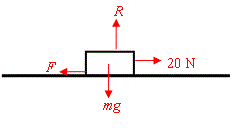Solution 9.4
From Mechanics
(Difference between revisions)
(New page: Image:9.4.gif As the block is moving relative to the surface the friction force must satisfy <math>F = \mu R</math> Also as the block has conmstant velocity the forces on it must be...) |
|||
| Line 19: | Line 19: | ||
<math>\uparrow :\quad R-mg=0</math> | <math>\uparrow :\quad R-mg=0</math> | ||
| - | <math>R=mg=4\times 9.81=39.24\ \text{N}</math> | + | <math>R=mg=4\times 9\textrm{.}81=39\textrm{.}24\ \text{N}</math> |
| + | |||
| + | Substituting in the friction equation, | ||
| + | |||
| + | <math>20 = \mu \times 39\textrm{.}24</math> | ||
| + | |||
| + | giving | ||
| + | |||
| + | <math>\mu = 0\textrm{.}51 </math> | ||
Current revision
As the block is moving relative to the surface the friction force must satisfy
\displaystyle F = \mu R
Also as the block has conmstant velocity the forces on it must be in equilibrium.
Resolving horisontally,
\displaystyle \begin{align} & \to :\quad 20\ \text{N}-F=0 \\ & \\ & F=20\ \text{N} \\ \end{align}
Resolving vertically,
\displaystyle \uparrow :\quad R-mg=0
\displaystyle R=mg=4\times 9\textrm{.}81=39\textrm{.}24\ \text{N}
Substituting in the friction equation,
\displaystyle 20 = \mu \times 39\textrm{.}24
giving
\displaystyle \mu = 0\textrm{.}51

